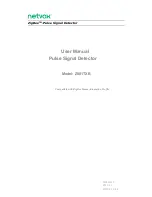
• Oil free, dry air of <20 % relative humidity or nitrogen must be used.
• The recommended flow is 5 l h
−
1
to 10 l h
−
1
(at 2 bar).
• For reliable operation we recommend dry air of <5 % relative humidity.
• The gas pressure must not exceed 2 bar.
• The minimum gas pressure is 1 bar.
• The humidity control shuts down the power of the detector modules when the humidity is too high (see chapter 6).
5.4.1. In-Vacuum Use for Detectors with Optional Vacuum Compatibility
The temperature and humidity control cannot prevent condensation issues and resulting damage to the sensor due to im-
proper use. Always make sure that the detector is warmed up (thermal stabilization unit temperature set to 25
◦
C) prior to
pumping down, venting, and opening the chamber. Only use dry air or nitrogen for venting. For in-vacuum operation no
nitrogen or dry air flow is necessary.
Warning
#6
When venting with nitrogen, take proper precaution against the risk of asphyxiation caused by oxygen
displacement from nitrogen. Ensure sufficient ventilation and oxygen level monitoring. Use compressed
dry air for venting large vessels or in confined spaces.
5.5. Connection to Thermal Stabilization Unit
The PILATUS3 R CdTe 100K-M detector is water-cooled and must be connected to a dedicated thermal stabilization unit.
Use only the provided thermal stabilization unit.
Warning
#7
For the maximum allowed coolant pressure in the cooling circuit of the detector see table 4.5.
In Air Operation
Use only the supplied hose couplings (RECTUS 204KL series).
Figure 5.5:
Horizontal Coolant Connection for Operation in Air (standard delivery condition).
In-Vacuum Operation
For in-vacuum operation unscrew the supplied hose couplings (RECTUS 204KL series) from the detector and use vacuum-
compatible fittings (1/8 inch ISO parallel thread) and o-rings.
PILATUS3 R CdTe 100K-M Technical Specifications v1.0.0
21 | 29









































